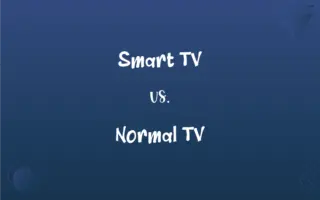Series Resonance vs. Parallel Resonance: What's the Difference?
Edited by Janet White || By Harlon Moss || Updated on October 6, 2023
Series Resonance occurs when circuit impedance is minimum; Parallel Resonance happens when circuit impedance is maximum.

Key Differences
Series Resonance refers to the phenomenon where in a series RLC circuit (Resistor, Inductor, Capacitor), the inductive and capacitive reactances are equal, minimizing the impedance. When this happens, the circuit allows maximum current to flow. Parallel Resonance, on the other hand, occurs in a parallel RLC circuit. At the point of resonance, the circuit's impedance reaches its maximum, minimizing the circuit's current.
Series Resonance circuits are often used for their ability to select or favor a particular frequency, like in tuning circuits of radios. Parallel Resonance circuits, in contrast, are typically utilized to reject certain frequencies, making them useful in applications like notch filters.
The bandwidth is generally broader in Series Resonance compared to Parallel Resonance, providing distinct characteristics in their operation.
Additionally, at Series Resonance, voltage across the components can be many times greater than the applied voltage, while in Parallel Resonance, current through the components can be much larger than the source current.
Comparison Chart
Circuit Configuration
Series RLC
Parallel RLC
ADVERTISEMENT
Circuit Impedance at Resonance
Minimum
Maximum
Current at Resonance
Maximum
Minimum
Usage
Favors or selects certain frequencies
Rejects certain frequencies
Example Application
Tuning circuits in radios
Notch filters in audio applications
Series Resonance and Parallel Resonance Definitions
Series Resonance
Utilized for frequency selection.
Series Resonance is critical for tuning applications.
ADVERTISEMENT
Parallel Resonance
Point of minimized current flow.
Devices use Parallel Resonance to reject unwanted frequencies.
Series Resonance
A phenomenon in a series RLC circuit.
At Series Resonance, the radio is tuned to a specific frequency.
Parallel Resonance
Where circuit impedance is at its maximum.
At Parallel Resonance, the current is at its lowest.
Series Resonance
Point of minimum impedance in a series circuit.
The circuit exhibits Series Resonance at a specific frequency.
Parallel Resonance
Utilized for frequency rejection.
Notch filters operate based on the principle of Parallel Resonance.
Series Resonance
Condition of maximum current flow.
The current is at its peak when Series Resonance is achieved.
Parallel Resonance
A phenomenon in a parallel RLC circuit.
The Parallel Resonance condition minimizes the circuit's current.
Series Resonance
Where inductive and capacitive reactances are equal.
Series Resonance enables maximum current to flow in the circuit.
Parallel Resonance
Condition of minimum current flow in the circuit.
Parallel Resonance is achieved when certain frequencies are eliminated.
FAQs
Does Series Resonance allow more current to flow?
Yes, at Series Resonance, the current flow is at its maximum.
How does Parallel Resonance differ?
Parallel Resonance occurs in a parallel RLC circuit, where impedance is maximum and current is minimized.
Where is Parallel Resonance commonly used?
Parallel Resonance is typically used in notch filters to reject certain frequencies.
How do the inductive and capacitive reactances compare at Parallel Resonance?
At Parallel Resonance, the inductive and capacitive reactances are equal, leading to minimized current.
Are Series and Parallel Resonance opposite phenomena?
In a sense, yes. Series Resonance minimizes impedance and maximizes current, while Parallel Resonance does the opposite.
What is Series Resonance?
Series Resonance is the point in a series RLC circuit where impedance is minimum and current is maximum.
Which resonance condition results in minimized current?
The Parallel Resonance condition results in minimized current.
What's the relation between impedance and frequency in Series Resonance?
In Series Resonance, as frequency approaches the resonant frequency, the impedance decreases.
Can Parallel Resonance be useful in audio applications?
Yes, Parallel Resonance is valuable in audio applications, especially in notch filters.
Is there a risk of component damage at Series Resonance?
Yes, due to the potential magnification of voltage across components at Series Resonance.
Can Parallel Resonance be achieved in a series RLC circuit?
No, Parallel Resonance is specific to parallel RLC circuits.
Can voltage magnify in Series Resonance?
Yes, at Series Resonance, voltage across components can be significantly greater than the applied voltage.
What role does capacitance play in Series Resonance?
In Series Resonance, the capacitive reactance equals the inductive reactance.
At what point is Parallel Resonance achieved in a circuit?
Parallel Resonance is achieved when the impedance of the circuit is at its highest, minimizing the current.
How does current behave in a circuit at Series Resonance?
At Series Resonance, the current in the circuit is at its peak.
What happens to the circuit's impedance at Parallel Resonance?
At Parallel Resonance, the circuit's impedance reaches its maximum.
Are both Series and Parallel Resonance found in RLC circuits?
Yes, Series Resonance is found in series RLC circuits, and Parallel Resonance is found in parallel RLC circuits.
Why is Series Resonance significant in radios?
Series Resonance is vital in radios for tuning to specific frequencies by favoring or selecting them.
Is the bandwidth broader in Series or Parallel Resonance?
The bandwidth is generally broader in Series Resonance compared to Parallel Resonance.
Why is Series Resonance important in filter circuits?
Series Resonance is crucial for selecting or favoring certain frequencies, making it valuable in filter circuits.
About Author
Written by
Harlon MossHarlon is a seasoned quality moderator and accomplished content writer for Difference Wiki. An alumnus of the prestigious University of California, he earned his degree in Computer Science. Leveraging his academic background, Harlon brings a meticulous and informed perspective to his work, ensuring content accuracy and excellence.
Edited by
Janet WhiteJanet White has been an esteemed writer and blogger for Difference Wiki. Holding a Master's degree in Science and Medical Journalism from the prestigious Boston University, she has consistently demonstrated her expertise and passion for her field. When she's not immersed in her work, Janet relishes her time exercising, delving into a good book, and cherishing moments with friends and family.































































